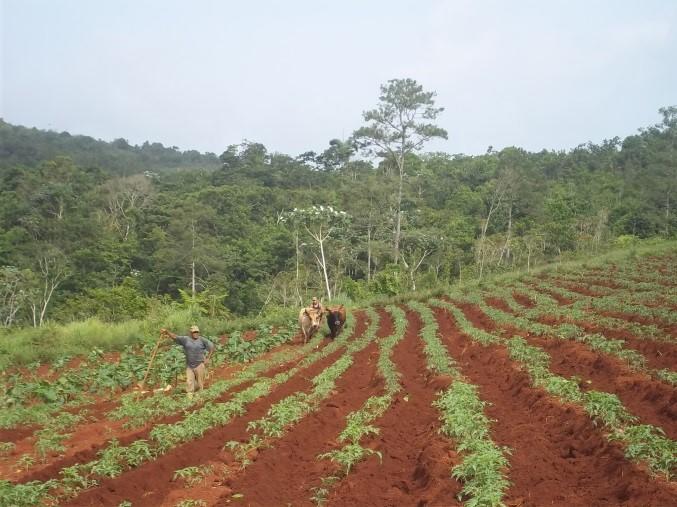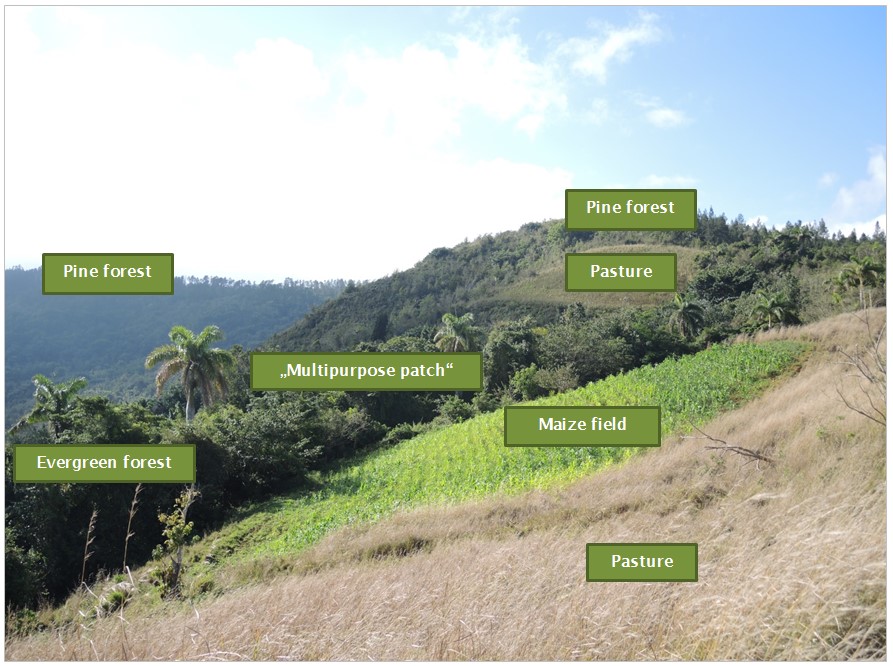Can the coexistence of nature and agriculture lead to the conservation of biodiverse landscapes?

Madeleine Kaufmann, Junior Advisor for Food Security at GIZ, highlights Bioversity International's and partners' work in the Cuchillas del Toa Man and Biosphere Reserve and writes about the many benefits that different farming systems and techniques can have on biodiversity conservation.
By Madeleine Kaufmann, Junior Advisor for Food Security at Deutsche Gesellschaft für Internationale Zusammenarbeit (GIZ)
Agriculture and related land use can have both beneficial and harmful effects on the environment, biodiversity, cultural heritage and recreation services, making the relationship between farming and landscapes a highly controversial issue. Similarly, the influence of agriculture on biodiversity has been debated for many decades. Agriculture is not harmful per se and one should appreciate the critical differences between various kinds of agricultural systems in terms of their potential to support biodiversity conservation.
This is a concept discussed at length by Perfecto and co-authors in the Nature’s Matrix: Linking Agriculture Conservation and Food Sovereignty book published in 2009, clearly states that farming can produce benefits for biodiversity and the management of the whole landscape. Perfecto et al. argue that a “particular type of agricultural practice can be a determinant of the biodiversity the ecosystem contains”.
The authors of Nature’s Matrix put agriculture in the centre of the landscape and focus on the so-called fragmented landscapes: “[...] almost all terrestrial ecosystems are now fragmented, the areas between fragments become crucial and those are composed largely of agricultural areas”.
Based on the concept of nature and human society, exclusionary approaches to nature conservation become irrelevant. Why? Firstly, because these kinds of approaches ignore the important role that indigenous and local communities have played in shaping many globally important and unique ecosystems and secondly, because these communities have contributed to the conservation of biodiversity and the particular type of agricultural practices over decades.
Another concept, which combines the protection of natural landscapes with sustainable management of farming systems in a mutually reinforcing way, is UNESCO’s concept of the Man and Biosphere (MaB) reserves. An interesting example is the Cuchillas del Toa MaB Reserve in the Guantánamo Province in eastern Cuba, where smallholder farmers manage the coexistence of natural vegetation with their cash and subsistence crops on-farm and combine managed and natural landscapes in a synergistic way.
Guantánamo’s farming families use elements of the wild flora diversity as living fences (pajua palm (Bactris cubensis)), shade trees in coffee plantations (coral tree (Erythrina poeppigiana)), to repel insects in home gardens (marigold (Tagetes patula)), or as timber for construction (e.g. majagua (Talipariti elatus)), and thus contribute to safeguarding certain natural habitats and conserving a considerable number of wild species.
However, in spite of the outlined positive signs, it could be shown that the local farming communities face a number of threats and challenges undermining their ability to sustain the present landscapes, ecosystems and agricultural biodiversity, which substantiate rural food security and have helped to develop and conserve the unique mosaic landscape in this reserve. Inadequate livelihood options – such as lack of access to education and medical care – are important driving forces which foster rural migration and thus lead to a relinquishment of traditional life ways and the adoption of environmentally unsustainable agricultural practices. Among many other reasons, the root causes of this problem are a lack of incentives that support traditional, agriculturally diverse farming practices, which take into account the interface between natural ecosystems and agricultural landscapes.
 In the Cuchillas del Toa MaB reserve, it is of utmost importance to enhance the understanding of the interaction between farming systems and landscape dynamics and on how farming communities can positively influence the integrity and resilience of managed and natural landscapes. At the policy level, the Cuban government needs to adopt integrated approaches that build on synergistic relationships between agricultural production, biodiversity conservation, and rural livelihoods within a whole landscape context, while at the same time providing farmers with valuable opportunities to obtain benefits from landscape management and agricultural biodiversity conservation (e.g. MaB reserve-linked food label). At farmer level, leadership roles need to be taken up in these initiatives and farmers have to find ways to collaborate and share their experiences more effectively, create new partnerships and integrate the conservation of cultural and spiritual values at all levels.
In the Cuchillas del Toa MaB reserve, it is of utmost importance to enhance the understanding of the interaction between farming systems and landscape dynamics and on how farming communities can positively influence the integrity and resilience of managed and natural landscapes. At the policy level, the Cuban government needs to adopt integrated approaches that build on synergistic relationships between agricultural production, biodiversity conservation, and rural livelihoods within a whole landscape context, while at the same time providing farmers with valuable opportunities to obtain benefits from landscape management and agricultural biodiversity conservation (e.g. MaB reserve-linked food label). At farmer level, leadership roles need to be taken up in these initiatives and farmers have to find ways to collaborate and share their experiences more effectively, create new partnerships and integrate the conservation of cultural and spiritual values at all levels.
There is no simple one-size-fits-all solution to implement the dual ’conservation‘ and ’sustainable use and development‘ goals in a MaB reserve area, but by successfully implementing the above-mentioned criteria, the MaB reserve model has the power to positively influence sustainable agricultural practices and biodiversity conservation worldwide.
~~~
This research was done in the framework of a Master’s Thesis project visiting 37 farmers in two distinctive agro-ecological zones of the Cuchillas del Toa MaB reserve in 2013 and 2014. The research was embedded in a larger project designed by the United Nations Environment Program (UNEP) and the Global Environment Facility (GEF) Trust Fund, with Bioversity International and the National Research Centre for Tropical Agriculture in Cuba (Instituto de Investigaciones Fundamentales en Agricultura Tropical Alejandro de Humboldt) as executing organizations. It is a 5-year project that aims to develop an innovative approach to nature conservation bridging the objectives of agricultural biodiversity conservation and the enhancement of livelihoods of agricultural communities in two MaB reserves in Cuba.
Contact Nadia Bergamini to learn more about this project.
